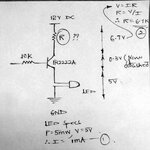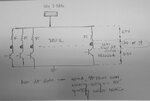blitzkreigist
Newbie level 4
I am from computer engineering background and I vaguely remember circuits from one of my undergrad classes. I am making a simple circuit for one of my projects and I need to know if what I am doing is correct before blowing things up (again!).

I have a 12V battery (7.2Ah). I am using that to power a LED whose specifications are 5mW, 5V. I am using PN2222A as the switch with base connected to 10K. I need to find the resistance in series which provides enough drop in voltage. So I designed the circuit as above. from (1) I = 1mA. so I derrived R as 6.7V/1mA = 6.7K Ohms. Is this correct?

I have a 12V battery (7.2Ah). I am using that to power a LED whose specifications are 5mW, 5V. I am using PN2222A as the switch with base connected to 10K. I need to find the resistance in series which provides enough drop in voltage. So I designed the circuit as above. from (1) I = 1mA. so I derrived R as 6.7V/1mA = 6.7K Ohms. Is this correct?
